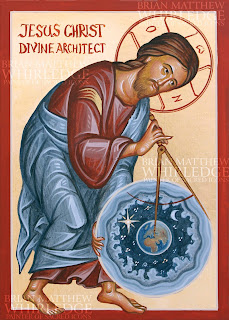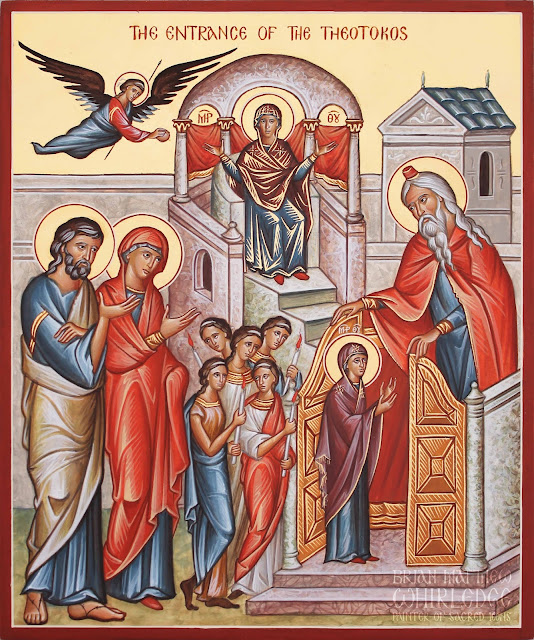The Nativity in the Flesh of Our Lord, God, and Saviour Jesus Christ
 |
The Nativity of the Lord. 2020. Egg tempera and gold on panel. 10x12" (25x30cm). |
The icon of Our Lord's Nativity is loaded with meaning as it describes the events surrounding Christ's birth. The primary theme of the icon is Emmanuel (God with us): the meeting of heaven and earth as God bows the heavens low and becomes man on earth. In this icon, the earth reaches up and touches heaven, which is coming down to meet it.
The icon is divided in three registers: the top is the heavenly, with the star and angels. The bottom is the earthly, with Joseph's doubt and the newborn Jesus being washed by a midwife. The center shows the meeting of heaven and earth: Christ is born to the All-Holy Virgin Mary and is worshipped by the shepherds and magi. I will explain this icon scene by scene.
The Star and the Angels
 |
| Detail of the Star and Angels |
The Star
"Lo, the star, which they saw in the east, went before them, till it came and stood over where the young child was. When they saw the star, they rejoiced with exceeding great joy." (Matthew 2:9-10)
The Angels
"And, lo, the angel of the Lord came upon them, and the glory of the Lord shone round about them: and they were sore afraid. And the angel said unto them, 'Fear not: for, behold, I bring you good tidings of great joy, which shall be to all people. For unto you is born this day in the city of David a Saviour, which is Christ the Lord. And this shall be a sign unto you; Ye shall find the babe wrapped in swaddling clothes, lying in a manger.' And suddenly there was with the angel a multitude of the heavenly host praising God, and saying, 'Glory to God in the highest, and on earth peace, good will toward men.'" (Luke 2:9-14)
The Birth of the Lord in a Cave and His Lying in a Manger
"And she brought forth her firstborn son, and wrapped him in swaddling clothes, and laid him in a manger; because there was no room for them in the inn." (Luke 2:7)
The earliest tradition is that our Lord was born in a cave, and laid in a stone manger, attested by local Palestinian St. Justin Martyr in the second century. The cave and manger can be visited today in one of the world's oldest churches in Bethlehem, Palestine. The manger, a food trough, and Bethlehem, meaning "house of bread," are very Eucharistic, recalling Christ the Bread of Life, offered as food for the faithful. The swaddling cloths and stone manger are visually anticipating the tomb and grave clothes of the Lord's life-creating death, burial, and three-day entombment.
The All-Holy Mother of God and Ever-Virgin Mary
"Today the Virgin gives birth to the Transcendent One, and the earth offers a cave to the Unapproachable One! Angels with shepherds glorify Him! The wise men journey with a star! Since for our sake the Eternal God was born as a Little Child!" (Kontakion of Christmas)
"And in the sixth month the angel Gabriel was sent from God unto a city of Galilee, named Nazareth, to a virgin espoused to a man whose name was Joseph, of the house of David; and the virgin's name was Mary. And the angel came in unto her, and said, 'Hail, thou that art highly favoured, the Lord is with thee: blessed art thou among women.' And the angel said unto her, 'Fear not, Mary: for thou hast found favour with God. And, behold, thou shalt conceive in thy womb, and bring forth a son, and shalt call his name JESUS. He shall be great, and shall be called the Son of the Highest: and the Lord God shall give unto him the throne of his father David: And he shall reign over the house of Jacob for ever; and of his kingdom there shall be no end.'" (Luke 1:26-33)
"Magnify, O my soul, her who is more honorable and more exalted in glory than the heavenly hosts. I behold a strange and wonderful mystery: the cave a heaven, the Virgin a cherubic throne, and the manger a noble place in which hath lain Christ the uncontained God. Let us, therefore, praise and magnify Him." (Hymn to the Theotokos on Christmas)
"But Mary kept all these things, and pondered them in her heart." (Luke 2:19)
The Ox and the Ass
The ox and the ass, while not mentioned in the Biblical accounts of Christ's birth, have always been included in icons since the earliest artistic depictions.
"The ox knows his owner, and the ass his master’s crib: but Israel has not known me, and my people have not understood." (Isaiah 1:3)
The ox, a clean animal, represents the Jews. The ass, an unclean animal, represents the gentiles. Christ's birth brings salvation to all, calling not only the Jews, but also the gentiles. This theme is repeated with the shepherds (Jewish, poor, and simple were the first to worship Christ) and the Magi (gentiles, elite and intellectual also worshipped Christ, but arrived later).
The Shepherds
 |
| Detail of the Shepherds |
 |
| Detail of the flocks |
The Shepherds
"And there were in the same country shepherds abiding in the field, keeping watch over their flock by night…And it came to pass, as the angels were gone away from them into heaven, the shepherds said one to another, 'Let us now go even unto Bethlehem, and see this thing which is come to pass, which the Lord hath made known unto us.' And they came with haste, and found Mary, and Joseph, and the babe lying in a manger." (Luke 2:8, 15-16)
The shepherds, who were poor and simple, but faithful Jews, were the first to hear the good news of the coming of the Messiah, and the first to come worship Jesus Christ, the God-man.
The Magi
 |
| Detail of the Adoration of the Magi |
The Magi
"Thy Nativity, O Christ our God, has shone to the world the Light of wisdom! For by it, those who worshipped the stars, were taught by a Star to adore Thee, the Sun of Righteousness, and to know Thee, the Orient from on High. O Lord, glory to You!" (Troparion of Christmas)
"Now when Jesus was born in Bethlehem of Judaea in the days of Herod the king, behold, there came wise men from the east to Jerusalem, saying, Where is he that is born King of the Jews? for we have seen his star in the east, and are come to worship him....And when they were come into the house, they saw the young child with Mary his mother, and fell down, and worshipped him: and when they had opened their treasures, they presented unto him gifts; gold, and frankincense, and myrrh." (Matthew 2:1, 11)
The Magi were elite priestly scholars and scientists from the east, possibly Persia or Mesopotamia. They were the first gentiles to acknowledge and worship the God-man Jesus Christ's coming in the flesh. They represent all the nations who would come to faith in Christ. They also represent all mankind, both young, mature, and old.
Their gifts of gold, frankincense, and myrrh are very significant. Gold is for the Messiah-king, the Son of David, whose kingdom will never end. Frankincense is due only to God, acknowledging Jesus Christ as fully divine, and also his role as the great high priest. Myrrh is ointment for burial, acknowledging Jesus Christ’s full humanity and mortality, in anticipation of the Lord’s passion, death, and burial.
Saint Joseph and the Tree of Jesse
 |
| Detail of St. Joseph and Jesse's Tree |
The Doubt of St. Joseph
"Now the birth of Jesus Christ was on this wise: When as his mother Mary was espoused to Joseph, before they came together, she was found with child of the Holy Ghost. Then Joseph her husband, being a just man, and not willing to make her a public example, was minded to put her away privily. But while he thought on these things, behold, the angel of the Lord appeared unto him in a dream, saying, 'Joseph, thou son of David, fear not to take unto thee Mary thy wife: for that which is conceived in her is of the Holy Ghost. And she shall bring forth a son, and thou shalt call his name JESUS: for he shall save his people from their sins.' Now all this was done, that it might be fulfilled which was spoken of the Lord by the prophet, saying, 'Behold, a virgin shall be with child, and shall bring forth a son, and they shall call his name Emmanuel, which being interpreted is, God with us.' Then Joseph being raised from sleep did as the angel of the Lord had bidden him, and took unto him his wife: And knew her not till she had brought forth her firstborn son: and he called his name JESUS." (Matthew 1:19-25)
St. Joseph is contemplating the great mystery of the Virgin Birth and the Lord's incarnation. He is shown at the bottom of the icon, in the "earthly" register, as he wrestles with these great mysteries, as do we who are on earth. He is shown far away from the Virgin Mother and Child to further emphasize he is not the child’s father.
The Tree of Jesse
Near St. Joseph is the Tree of Jesse. “A shoot shall sprout from the tree of Jesse and from his roots a bud shall blossom. The spirit of the Lord shall rest upon Him” (Isaiah 11:1-2)
Jesus Christ can trace his lineage to King David and Jesse through both his mother and foster-father. David, the son of Jesse, is the primary prototypical Messianic figure in the Old Testament. Christ’s Davidic lineage and his birth in Bethlehem are key for his Messianic kingship.
The Midwife
 |
Detail of the Midwife |
The Midwife
This scene shows a midwife washing the newborn Jesus after assisting with the birth. While not described in scripture, this very earthly scene attests to the full humanity of Christ God's incarnation and has been included in icons of the Nativity since antiquity.




Comments
Post a Comment